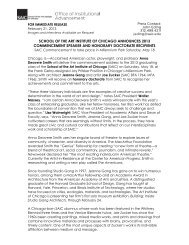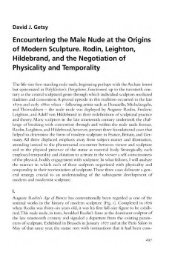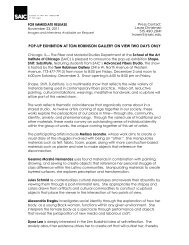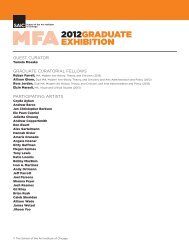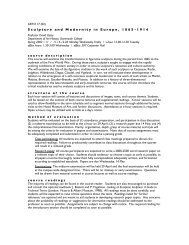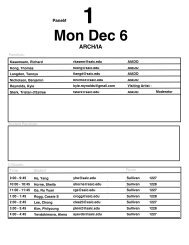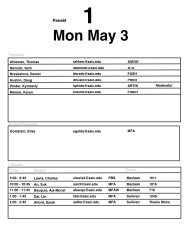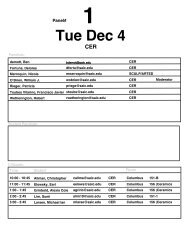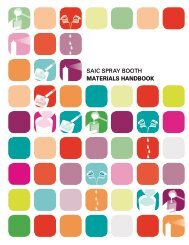i. institutional support and commitment to continuous improvement
i. institutional support and commitment to continuous improvement
i. institutional support and commitment to continuous improvement
You also want an ePaper? Increase the reach of your titles
YUMPU automatically turns print PDFs into web optimized ePapers that Google loves.
School of the Art Institute of Chicago<br />
Department of Architecture, Interior Architecture, <strong>and</strong> Designed Objects<br />
Master of Architecture<br />
Master of Architecture with emphasis in Interior Architecture<br />
Course Number & Title:<br />
ARCH & INARC 6221 Structures 3: Complex Organi-<br />
zations (1.5)<br />
Course Description:<br />
This integrated technical practice course advances<br />
underst<strong>and</strong>ing of integrated construction systems,<br />
with a focus on structural forms <strong>and</strong> their design.<br />
Topics for study include: gravity <strong>and</strong> lateral loading,<br />
load path, material properties, section properties,<br />
truss analysis, long span structures, lateral systems,<br />
steel <strong>and</strong> concrete member design, connections <strong>and</strong><br />
structural drawings. The course consists of multiple<br />
design projects. The instruc<strong>to</strong>rs lead a series of<br />
lectures or design charrettes related <strong>to</strong> each project.<br />
Classes are comprised of lecture, discussion <strong>and</strong><br />
guided project design time.<br />
Course Goals & Objectives:<br />
1) Design practice: develops knowledge in struc-<br />
tural systems <strong>and</strong> an underst<strong>and</strong>ing of the role<br />
that structural considerations play in design deci-<br />
sions.<br />
2) Building science skills: develops the ability <strong>to</strong><br />
guide a team through the design process, <strong>to</strong> com-<br />
municate critical design information <strong>to</strong> structural<br />
consultants <strong>and</strong> integrate structural drawings <strong>and</strong><br />
specifications in<strong>to</strong> project documentation.<br />
3) Building science skills: focuses on developing<br />
investigative skills empowering students <strong>to</strong> evalu-<br />
ate the pros <strong>and</strong> cons of structural systems <strong>and</strong><br />
materials during pre-design.<br />
4) Structures skills: reinforces underst<strong>and</strong>ing of<br />
physical principles in statics <strong>and</strong> the mechanics of<br />
materials.<br />
5) Structures skills: delivers useful concepts of<br />
load distribution, component spacing <strong>and</strong> system<br />
performance allowing students <strong>to</strong> integrate struc-<br />
tural concepts in studio projects.<br />
6) Structures skills: explores the code prescribed<br />
design methods applied by the professional com-<br />
munity.<br />
7) Structures knowledge: introduces best prac-<br />
tices for structural system layouts for multiple<br />
typographies with a focus on performance based<br />
design.<br />
8) Structures knowledge: introduces the reference<br />
materials <strong>and</strong> organizations responsible for sharing<br />
information about the latest structural technolo-<br />
gies <strong>and</strong> <strong>to</strong>ols for their implementation.<br />
9) Structures knowledge: provides the under-<br />
st<strong>and</strong>ing of structural principles required <strong>to</strong> study<br />
for the ARE exam<br />
Architecture Program Report | 184<br />
Student Performance Criterion:<br />
1) Best exemplifies the following criteria:<br />
Topical Outline:<br />
a) B.9. Structural Systems (underst<strong>and</strong>ing)<br />
1) Structures skills: reviews knowledge of physical<br />
principles, including static, mechanics, load distri-<br />
bution, <strong>and</strong> basic material design practices.<br />
2) Structures knowledge: Project 1 reviews internal<br />
forces, section properties <strong>and</strong> material properties;<br />
introduces concepts on wind forces, wind phenom-<br />
ena, mixed-materials connections <strong>and</strong> detailing,<br />
welding <strong>and</strong> bolting details; 20% of the course.<br />
3) Structures knowledge: Project 2 introduces<br />
detailed truss analysis <strong>and</strong> associated numeric<br />
methods, design for tension <strong>and</strong> compression<br />
members, member optimization, unbalanced<br />
forces, foundations; 20% of the course.<br />
4) Structures knowledge: Project 3 reviews load<br />
path concepts; introduces integrated concrete<br />
slab, beam <strong>and</strong> column design, <strong>and</strong> load transfer<br />
at dis<strong>continuous</strong> columns; 20% of the course.<br />
5) Structures knowledge: Final Project introduces<br />
lateral load resisting systems, seismic loading crite-<br />
ria <strong>and</strong> basic design considerations, high rise build-<br />
ing typographies, floor vibration, building move-<br />
ment <strong>and</strong> dynamic response; 40% of the course.<br />
Prerequisites:<br />
All required fifth semester courses<br />
Textbooks/Learning Resources:<br />
Various sources including:<br />
• Onouye, Barry & Kane, Kevin. Statics <strong>and</strong><br />
Strength of Materials for Architecture <strong>and</strong> Build-<br />
ing Construction<br />
• Ching,Francis D.K., Onouye, Barry S., Zuber-<br />
buhler, Douglas. Building Structures Illustrated<br />
Offered (semester <strong>and</strong> year):<br />
• Semester: SPRING<br />
• Year: THREE<br />
Faculty assigned:<br />
• 2009-2010 academic year:<br />
Joseph Shields (P/T), JiYoung Moon (P/T)<br />
• 2010-2011 academic year:<br />
JiYoung Moon (P/T), Jeannette Pfeiffer<br />
(P/T)



